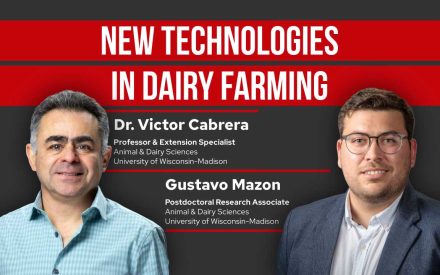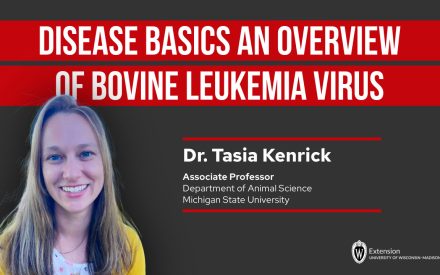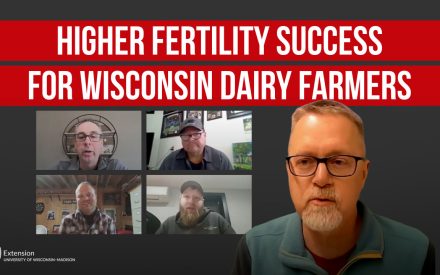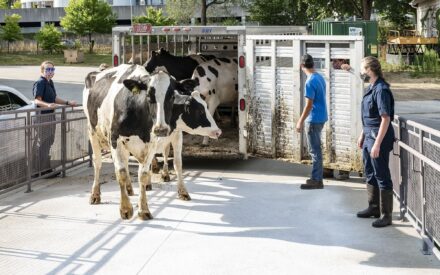Introduction
Bovine leukosis infection in cattle, like PFAS chemicals, is almost universal in dairy herds. Yet, unlike PFAS, we don’t have to resign ourselves to living with it; we can take specific steps toward its control and elimination. We will report on the progress of one herd toward that goal. Presented by Phil Durst, field-based Educator with Michigan State University.
Highlights
🐄 BLV Compromises Immune Systems: The virus is detrimental to cows’ health, making them more susceptible to diseases and affecting vaccine effectiveness.
💰 Economic Impact: BLV incurs significant costs for dairy farms, both in terms of health management and reputation.
🧪 Advancements in Testing: Transitioning from ELISA to PCR testing allows herds to identify the most at-risk animals, improving management strategies.
🌱 Collaborative Approach: Forming teams of producers, veterinarians, and educators enhances knowledge sharing, accountability, and effective implementation of practices to reduce BLV.
📉 Successful Reductions: Several herds have achieved significant reductions or zero prevalence of BLV through targeted strategies and risk management.
🔄 Long-Term Commitment: Managing BLV requires patience, ongoing testing, and a willingness to adjust practices over time.
📅 Data-Driven Decision Making: Utilizing herd profile testing and continuous monitoring can guide producers in making informed decisions about their herd management.
Summary
In this video transcript, the speaker discusses the issue of Bovine Leukemia Virus (BLV), its detrimental effects on cattle health, farm economics, and dairy farming reputations. They emphasize the preventability of BLV and articulate strategies to help dairy farms reduce the prevalence of this virus. The speaker shares the results of various research projects from 2015 to 2021, which involved testing and monitoring herds to identify the best methods for managing BLV transmission risk. They explain the transition from ELISA testing to more advanced PCR testing, allowing for more accurate viral load assessment among infected animals. The speaker highlights a nationwide initiative to unite producers, veterinarians, and extension educators into teams focused on eradicating BLV. The results of ongoing research reveal that specific herds successfully reduced or maintained zero prevalence of BLV, while also underscoring the need for a commitment to long-term strategies and best practices. The narrative promotes the importance of collaborative work and evidence-based approaches in tackling this viral threat to dairy cattle.
Transcript
BLV is not like POS. It doesn't have to last forever. And once you accept that BLV is detrimental to the health of cows, and Tasia explained that it compromises the immune system, that cows are not protected as well from the vaccines, that they're more susceptible to other diseases. Once you accept that it's costly to the farm and TA just showed you some some uh cost figures uh that cost per cow on a farm and once you accept the fact that it's damaging to the reputation of dairy farming she didn't mention that but I will mention
that is is that we have cows that are chronically infected and we tolerate that and frankly that's a hard thing for consumers to to understand that why do we tolerate chronic infection of cows and and frankly they have a right to question that. And then the last point is that once you know that it's preventable, the next question should be how do I get rid of it? And that's been my focus as an extension educator. I'm on the side of okay, we've got it. Let's get rid of it. How's the best way to do
that? Uh, next slide, please. So early on in uh 2015 and 16, I was working with uh with recruiting herds to uh for a longerterm project to see how they could reduce the prevalence of BLV in their herds. Okay. So recruited 91 herds um in in the two years they for three-year project and we started them off with a herd profile test. Now herd profile test is an Eliza test of 40 cows in the herd. It's the 10 freshest cows of first lactation, the 10 freshest of second lactation, the 10 freshest of third
lactation, and the 10 freshest fourth and later lactations. And so it's 40 cows. And from that, we estimate the herd prevalence. Now, you may say 40 cows, how does 40 cows estimate the prevalence of a 500 cow herd or of a thousand cow herd or of a 5,000 cow herd? Okay? And the reality is that it's pretty good at at estimating the prevalence of those uh no matter what the herd size is. But it gives us an idea of how what the prevalence is within a herd. And so and back in those days 2015 16 it was the test that we
had. We didn't have PCR yet and so all we had was Eliza. And so we identified with these herds risks for BLV transmission. And Tasa told you that it's a the risk of transmission are with blood cells, white blood cells. And so when we transfer white blood cells either by transferring blood or by transferring white blood cells through milk or colostrum, we have a risk of infecting the other animal. Right? And we identified the risks on these 91 herds of BLV transmission and encouraged farmers to reduce those risks by
changing practices most commonly to reduce uh to not share needles and sleeves. And so just just to let you know it can be microscopic blood on needles that we that we take from one animal and give to the next animal. It can be microscopic blood on a sleeve that is used to examine one animal and we put that arm into the next animal and we can transfer blood that way. And so those are ways that we can transfer blood. Um as well as from uh feeding colostrum or or milk feeding especially when we pull milk and feed it to a group
of calves. If we pull milk from from 10 cows and two of them are BLV infected and shedding, we can infect the group of calves that that we give that milk to, right? And so then we we talked with producers about those risk things. We let them make their own decisions and then we did annual herd profile test to see what happened with prevalence. Over three years, some herds decreased prevalence significantly. That was great. But others did not and still others actually increased in prevalence. That was frustrating not just to me it
was frustrating to the farmers who who say well you know I'm doing these things and why is my prevalence going up? But we didn't have any other tools with which to to investigate this. Next slide. So PCR changed the field for us. Wow. What a great thing that would happen when when we had PCR available that we could actually now measure quantitatively. That's the Q in front of PCR quantitative. We can measure how much DNA there was, how much provirus there was in each of these animals. And so it gives us the ability to identify
not just the positive cows, but the cows that are the greatest risk to spread the virus. So I can take a bunch of positive cows and say these are the priority because they're the greatest risk. And so in using that information in conjunction with risk reducing practices, we can we can plan a program that's targeted to the herd. We can call individuals that are not only the worst threat to their herdmates but also the ones that are likely to have the greatest economic impact on their own health because we know that the higher
the proviral load the greater the economic impact on those animals from themselves. It also identifies the Eliza positive animals that we can ignore, right? Because frankly, when when we can't detect the BLV DNA in analyze a positive animal, we know that she's got antibodies to it, but but we can't find the virus, then I'm not worried about that animal. I can ignore that animal's fact that she's positive, and I can concentrate on the ones I have high uh BLV proviral load. Next slide. In 2021, we we uh started a new project. It
was a one-year grant and it was called moving to zero. And what we wanted to do was to take herds from our 2015 to 16 projects and those lasted three years. So they were ended in 1819. Take herds that were low in prevalence or had zero prevalence at that time because we didn't know what happened between the last test and 2021. And so we identified 10 herds that had lower to zero prevalence. And we did a whole herd Eliza test to identify positive and suspect cows. And then with the positive and suspect cows, we did a
a PCR test on those cows. And that would be our typically our typical route of of action is to identify the the cows that are positive on Liza and then to do a PCR on those positive animals to find out whether they're high, moderate, low, or undetected. And so using that information, producers could target calling to the cows with the highest proviral load. And so we gave the producers the information, we didn't tell them what they had to do with it, frankly. We we we allowed them to do whatever they wanted to do with it. And
then just we we followed up with them to see what happened. Okay, next slide. Well, the results were that four herds had zero BLV cows. So no cows pro no cows positive on the Eliza test and and that was good news because that means that we had tracked them over a period of six or seven years and they have been BLV negative that whole time. You know when when we say that that 94% of herds are infected. You might say well it's a given that any that every herd will be infected at some point in time. That may not be true. And of these
negative herds, you know, some of them were a couple hundred cows in size. Uh but even so, they had not bought cattle in and so that that was the critical uh difference in that case. So four herds maintained that negative status. One herd during the project bought cows. They were doing really well in reducing uh BLV prevalence in the herd and then they bought cows and wow they found out that those cows were infected. The other five herds reduced prevalence by reducing risk transmission and by calling the high shedters. Now during
this one-year period, no herd eliminated all the BLV positive animals. All right. And we recognize that the decision to call an animal uh based on a test result is is a little um shaky ground for some producers who say that animal is a great producer. Why would I call her? Well, she's also shedding virus. And so, you know, producers have that that struggle of of calling animals versus um the milk production that they're giving. So, it takes time to reduce this. And also, as a part of that study, we calibrated a a
test that could accurately distinguish bulk tank milk from negative herds to those with very low prevalence. We knew we could always find high prevalence herds by bulk tank testing, but we didn't know how low we can go in prevalence. We found that we could we can have one or two out of 50 cows and still be able to detect that in the bulk tank. Next slide. So what does it take to be effective in controlling BLV to to be effective in getting rid of this disease? Well, Dr. Don Niles was at the BLV conference and and Tasa mentioned
the all things BLV conference coming up in in the July this year. He was at the conference two years ago, I believe it was, at Michigan State, and he said this. He said, "Any significant animal care changes have started out with an innovative veterinarian and an innovative client working together to create a change that makes sense to them." I thought, "Wow, okay, let's see what we can do with that." And so we wanted to tas and I talked about this. We wanted to start a nationwide project that would create teams in the top dairy
states, teams that would consist of a producer, their veterinarian, and their extension professional working together to reduce BLV in that producer's herd. And we wanted to have these teams in each of these states so that it would give it would give a a a knowledge of BLV reduction in these states because frankly we we don't believe that's very widespread. And so I contacted extension agents in several states about supporting the project and Erica was one of those and and I contacted Erica and
she was glad to to participate in that project but we failed to get the proposal put together and and and I'll take the blame on that and so we just didn't get it done. However, Erica was persistent and she kept asking about it because she had a herd that was interested in it. Next slide. Well, Erica's persistence won me over. All right. And so I got a grant, a Michigan grant to work with a Wisconsin herd. I don't know how that one got through, but indeed it did. And so one herd, their veterinarian and their
extension educator, which is Erica. And so I visited the farm in January 2024 along with the vet and Erica. And and we sat down together and we talked about the herd, the herd management. We talked about BLV. We talked about what we know about BLV control and eradication. And you know, I I said, "Here's the grant, and this is how much I have to spend for testing. You can determine how you want to spend it for testing. That's your determination. I just tell you what the limit is." And so we we we talked with
them about that. And then we set up Zoom calls every other month to check on progress, to ask questions, to talk about actions, and and to ask everybody to participate in those calls. That is all three of the partners because we want this team, the team of the producer, the veterinarian, the extension agent to be a focal point of getting that information out broader and to and to be successful working together. Next slide. And so this is a a high producing herd of more than 500 cows. Their initial herd profile test showed 53%
prevalence with a big increase in prevalence from first lactation to second lactation from 10% to 70%. All right. Now that again a herd profile test is a test of 40 cows, right? 10 cows of each of the lactations. And the producers said, "Yeah, well that's 40 cows. I don't really think that that is going to estimate the BLV prevalence in my herd." So they elected to do a whole herd Eliza test. It turns out that the positive animals plus the sus animals equal 53% of the herd. I guess it just shows, but
frankly, I don't think it's always going to be that close, but I was really glad that it was uh exactly the same prevalence that that uh the herd profile test showed. I don't expect it to be that close all the time. I expected just to give us a good idea of what the prevalence is in the in the herd when we do a herd profile test. But anyway, their goals were to keep negative cows negative. That means reduce transmission. And reducing transmission involves practice changes and it involves what we do with animals. And so
the second goal was to reduce the number of positive animals who are the greatest risk to negative cattle. All right. So those were their goals going into this. Next slide. They took some actions. They said we will do these things and we will do these things in order to reduce the percent the the the risk of transmission. And so they said we'll we'll do single needle use. We'll stop using needles for multiple animals. And not only did they stop it at the farm that they that they operate, the the
mature cow farm, but they also asked their heer grower to use single-use needles there as well. They said they would breed any positive cow to beef. They're saying we don't want the offspring of a positive cow because the the potential and and Tasia mentioned, you know, the fact that that the offspring the calves of of of positive dams were 3.2 two times more likely to be come positive at a later time than than those from negative animals. So they didn't want offspring from positive cows on the farm. They also elected to
test heers as they freshened and that was something that they wanted to do just to see how heers were coming in. And they said we'll clean and disinfect the maternity pen after every four to five calves. Now, somebody may say, "Well, well, Phil, you know, wouldn't it be better to clean and disinfect the maternity pen after every every calf or after every positive dam gives birth?" And I would say, "Sure, but the reality is whatever the program is, it has to be practical because if it's not practical,
it will not be kept up." And so if you start something that's too aggressive, that's too impractical and don't keep it up. That's worse than not starting that at all at that level. I would always say start at some level and then you can always increase the level later. So if today they're they're cleaning it after every four to five calves. Maybe at some point they'll clean it more frequently than that. I don't know. But at this point I say, uh, great. I'll take what you're willing to give. Next slide.
So follow through. Did they follow through? And the answer is absolutely. All parties were on each call. We had I think five or six calls meeting every other month. Um there was they did regular testing the fresh heers. They were consistent in breeding every positive cow to beef no matter what the genetic value of that cow is. And that's a major deal because you know some of those cows have got high genetic value and yet they were breeding positive cows to beef. Positive cows were identified. There was good
compliance on the single-use needles at the heer growers as well at the home farm. And they found another source of needles and syringes so that they could buy them cheaper. So the cost did not go up much. They also were always using new sleeves for breeding overall and but they don't use new sleeve. I don't believe the vetinarian uses new sleeves for every animal. All right, that's one of those compromises. But again, compromise is is is where you can find the practical road even if the risk may
be a little higher and overall labor was not was not changed much. And so that was good news, but they were willing to spend more time in labor if if it would result in lower risk, but overall labor was was unchanged. Next slide. So follow-up testing uh in in September of 24 uh they they tested the whole herd and it was at 23% prevalence uh that was down significantly to 53% prevalence in February and of 62 uh head that were posit eliza positive animals were tested. There was zero that were high.
Now high is is the ones that we want to get rid of because they're the they're the greatest shedters. Only six were moderate, 34 were low, and 21 were undetected. 21 I could ignore, I can I can live with the 34 that are low. And if we had had high ones, I might even say I can live with the moderate ones and and and and get by with them. But now I look at six moderate ones and think, wow, what I want to do with six moderate ones is I want to get rid of them because I want to reduce my risk even more. So they made tremendous
progress in a short period of time. And I think that's key to remember is that they were able to make uh a lot of progress. They're not down to zero and they understand that getting to zero is a long-term process. Next slide. Uh keep going. Um what happened there? Go back and see what happens and see if we can get Well, apparently those things didn't show up. So Oh, no. Sorry. That's all right. Let me just uh tell you what's on the slide and try to remember what's on the slide. So first of all, every farm is different. Don't
expect that somebody else's results will be this what results you might achieve because every farm, every farmer, everybody's cows, everybody's resources, everyone's uh situation is different. In fact, that cow down there is a butter cow at the Iowa State Fair. That's certainly a different cow. I don't think it was be infected. So that's a different cow. And every firm is different. But what you can expect is that we believe that no matter what the situation is that with conscientious progress, every firm
can make progress. It may take longer for some to get to zero than others. It may not be the goal to get to zero, but truly we believe that each farm has a capability to make progress on this disease, but it takes individual consultation in order to get that. Go ahead. Next slide. Now we did evaluations of the project and participants increased their understanding of BLV in all six areas measured. They understood the prevalence better. They understood the transmission better. They understood the risk
factors, the testing, the use of test results and the management better. And they reported that working together as a team and this is what we wanted to do. Bring them together as a team was beneficial because it ensured accountability. It helped to have another person to talk to about BLV. It provided a more comprehensive approach. It improved understanding as others asked questions and the project meetings that we had, the first one being in person, the next one being virtual were valuable because they provided
opportunity to solve problems together to keep the project on track and and helped plan a path forward. Next slide. The keys to success and I think these are critical. The first one is the producer attitude. If you want to succeed in this, you will. If you're iffy, if you're on the if you're on the fence on this, I don't expect great results. In this case, that farm that we worked at, they had a goal. Their goal was eradication. They said, "We look at it like yon disease. We want to eradicate it." And they were willing to
do what it took to eradicate it. Now, they're not there yet. And they recognize that it's a long-term process. But what they said was that if if we we believe that it's one less stress on the cow and that is positive in long run and if we can reduce the number of cows that are not salailable at the packing house that's a financial win especially at today's beef prices. They also had great reproduction success and so that reproductive success that they have enabled them to to be able to call cows
or breed cows to beef. They had a willing veterinarian to provide encouragement and worked with them. They had an active extension educator who took and sent the notes after each meeting to remind them of what was discussed and decided on. And they had patience and persistence. It's a long-term project. Next slide, please. So, my recommendations, start with the herd profile test to find out where you stand. Talk with your veterinarian, your extension professional about developing a plan to control it. Set your goals.
Make sure you have an accountability partner. This takes a long time. If you're going to do this, you've got to be held to your goals and stick with it. Be willing to invest in testing. I think you should set an annual budget for testing. Develop a plan for cals at each possible test result. Figure out what you're going to do ahead of time before you get the results back. That way, it's easier to make those decisions. Be willing to change practices. These are often the lowhanging fruit. And if you
have questions, seek help by including by by calling contacting Dr. Kendrick or myself. And you can go to the next slide which is simply just a thank you slide.
The University of Wisconsin–Madison Division of Extension provides equal opportunities in employment and programming in compliance with state and federal law.


 ▶️ Watch: New Technologies in Dairy Farming
▶️ Watch: New Technologies in Dairy Farming ▶️ Watch: Disease Basics An Overview of Bovine Leukemia Virus
▶️ Watch: Disease Basics An Overview of Bovine Leukemia Virus ▶️ Watch: Higher Fertility Success for Wisconsin Dairy Farmers: Panel Discussion
▶️ Watch: Higher Fertility Success for Wisconsin Dairy Farmers: Panel Discussion Resources for Highly Pathogenic Avian Influenza (HPAI) H5N1 virus in Cattle
Resources for Highly Pathogenic Avian Influenza (HPAI) H5N1 virus in Cattle


